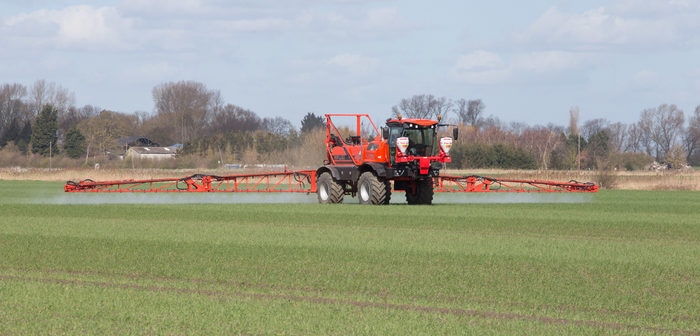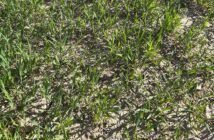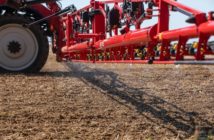With another season of variable winter wheat development extra care will be needed to manage crop growth and disease pressure this spring, agronomy firm, Farmacy says.
Essex and Suffolk-based Farmacy agronomist, Tom Smith, says some of the most forward wheats in his area were up to GS25 by mid-February, showing good growth and excellent potential. However, the majority were around GS23/24, while later-drilled crops that struggled to get going in cold, wet soils or those drilled in mid-November after potatoes were back nearer GS13.
“These are the extremes, but there’s a lot of variability out there, which poses challenges for early fungicide planning, and reinforces the importance of applying treatments according to growth stage, not calendar date.
“Growers also need to recognise that later, backward crops, often go through growth stages quickly as temperatures and day length increase, potentially complicating spray timings.”
Indeed, late-drilled wheats can often be the trickier crops to manage, especially if rapid growth results in weaker stems and increased lodging risk, he adds.
Protect potential
Head of Integrated Crop Management, David Howard, says that both forward and backward crops need managing carefully to protect and build potential, which all starts with the T0.
“We have seen before that growers can sometimes be reluctant to invest too much in thinner crops, cutting back on early T0 and T1 sprays, only to find they then had to chase disease hard at T2 to get it back under control.”
Yellow rust in particular can be more pronounced in late-sown or stressed wheats, and thinner crops are also more reliant on lower leaves to help them catch up, therefore protecting photosynthetic capacity is key, despite the potentially lower yield potential, he says.
With recent seasons indicating rust and septoria are becoming more aggressive and better adapted to changing weather patterns, effective early disease control is vital to stay on the front foot in any crop, he adds.
“The T0 fungicide may not offer the same yield responses as later treatments, but it sets the foundations for effective disease management, and crucially, helps manage the pressure on subsequent treatments and key yield-building leaves.”
Rust focus at T0
Historically, septoria was the main target at T0, and while septoria control remains important in high-risk varieties and regions the focus has shifted towards managing rust, says David.
“Last year saw a particularly early appearance of brown rust in some crops, and after a high pressure season, there could be more inoculum around this spring, although much depends on the impact of winter frosts in reducing inoculum, or at least delaying onset. Equally, milder conditions, like last season, could result in earlier rust pressure.
“Rust management is a numbers game; you must act early to slow it down before inoculum builds. An effective T0 is a ‘no-brainer’ for anyone growing wheat in higher rust-risk areas of eastern counties.”
Tom agrees. “While there has been a bit of septoria bubbling away on older leaves, we’ve not seen much yellow rust in crops so far, but that could change quickly once conditions warm up. Although we did have a cold spell during January, conditions in this area have generally been quite mild through the autumn and winter, so inoculum is still likely to be there.”
In most situations, he says tebuconazole is his preferred option for controlling yellow rust at T0, in combination with a strobilurin such as azoxystrobin for extra persistence. For those looking to boost septoria protection, consider including a multi-site like folpet, he notes.
“As always though, fungicide choices should be based on individual situations, considering things like variety, growth stage, previous cropping, drilling date, the weather, and what disease(s) you’re seeing in the field at the time.”
Growth manipulation benefit
GS30 is also an ideal time to apply a plant growth regulator, such as trinexapac-ethyl or chlormequat, to manipulate plant growth, says Tom. The aim is to control apical dominance and help balance the flow of nutrients and energy across the leaves, stems and developing spikelets, giving the plant the best chance of retaining as many tillers as it can support, with strong stems and large ears.
There is an important distinction between this early growth ‘manipulation’ and the use of PGRs at the later GS31/32 or 37/39 timings, where the focus is on growth ‘regulation’ by shortening and strengthening the stem to reduce lodging risks, he notes.
Timing is everything
Finally, David advises growers to be open-minded about T0 spray timing.
“Typically, many wait for GS30, but crops are sometimes beyond that by the time of application, and when catchy weather delays spraying, some may wait until the T1 and perhaps try combining the two.
“Having a gap between T0 and T1 is beneficial though, so be flexible with the early timing. If disease is present and you are 2-4 weeks out from T1, it is worth treating, subject to product label restrictions.”
Many products can only be used from GS30 onwards, but there are some that can be applied earlier, including biological controls, he notes.




